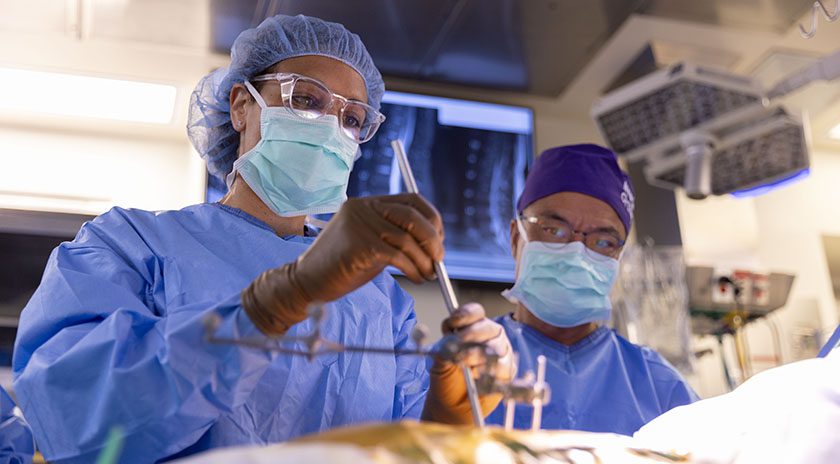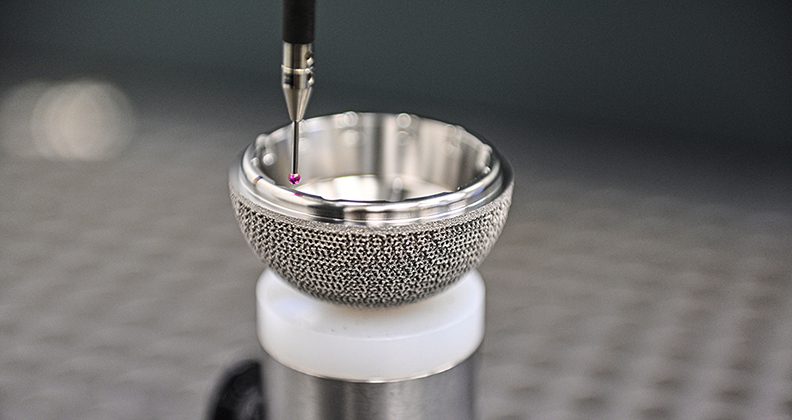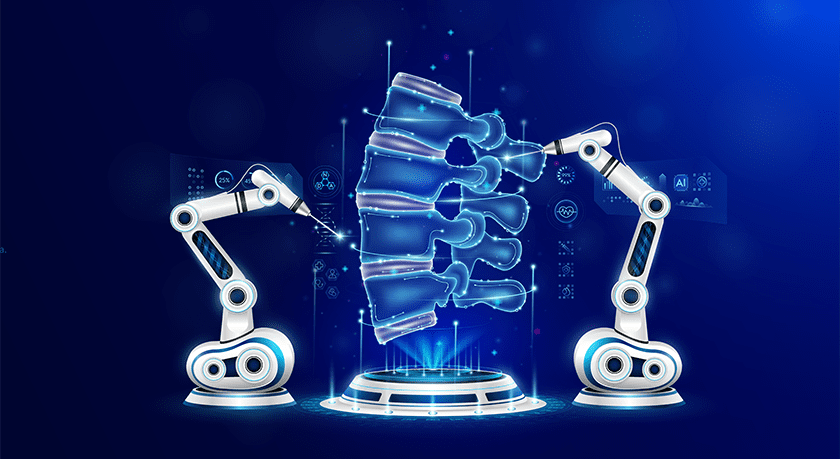

 Copy to clipboard
Copy to clipboard 
Orthopedic companies are pursuing the personalization of procedures in an effort to achieve better implant positioning, reduce revision rates and meet the needs of complex surgical cases. As a leader in this movement for decades, Materialise has helped more than 500,000 patients through personalized solutions, such as guides and implants, and its software has been used to analyze more than 6 million patient scans.
Materialise’s growth in recent years has primarily come from its medical business. From 2023 to 2024, its revenue from medical devices and services increased by 15%, and revenue from medical software grew by 14%. Its notable orthopedic company collaborations include agreements with Johnson & Johnson, Zimmer Biomet, Smith+Nephew, Exactech and Ortho Development.
As surgeons and industry embrace the idea of personalized surgery, the focus on procedure planning becomes more critical, said Materialise CEO Brigitte de Vet. Materialise is a software company at its core and believes that advanced tools will push the boundaries for personalization in orthopedics.
We spoke with Ms. de Vet about the applications that meet the moment and the future of orthopedic care.
Your medical business experienced double-digit growth in 2024. What drove that success?
Ms. de Vet: When people hear personalized solutions, they immediately think of implants. Yes, we manufacture implants, but we also offer instrumentation and preoperative planning. The value of these solutions has been proven over the last few years and was a driver of our growth in 2024.
People initially questioned the value of personalized solutions. We put effort into making them accessible, bringing them to patients faster, and making the process from the image to the O.R. easier for users. We’ve achieved milestones in demonstrating the solutions’ value, which has led to their adoption and growth.
Where is the industry now in the evolution of personalized medicine?
Ms. de Vet: The answer differs by anatomy. The adoption and value of personalized solutions have been established in many instances in orthopedics. Consider acetabular cups. Cutting guides for knee replacement have been around for decades. There are other anatomies where we’re still at the very start of the adoption of personalized solutions and where the use case may be less established.
We are hearing about more interest in shoulder replacement and foot & ankle. Why have those segments fallen behind large joints? And have you thought about expanding into the spine market?
Ms. de Vet: The adoption is there for shoulders and foot & ankle, but there’s still a lot of ground for the industry to cover. The main reason is accessibility. Industry can do a better job of decreasing the complexity of the process and the cost of the implants to make them available to everyone.
I wouldn’t exclude spine from future conversations, but the use case is less clear. We focus on areas where there’s a clear unmet medical need, and a personal solution can benefit the patient and healthcare system. Spine is an area where I’m less convinced that there’s a significant benefit for all the parties involved.
What does the future hold for personalized solutions in orthopedics?
Ms. de Vet: We’ll never reach 100% of orthopedic devices being personalized — it doesn’t make sense when traditional devices work so well for most patients. Personalized solutions make sense for unmet needs.
Revisions of acetabular cups, for instance, can be complicated. We know that 27% of revision cases come back for a third intervention — and the probability of reoperation increases each time. That’s a huge cost for the healthcare system and very difficult for the patient. The data on our personalized acetabular cup, which we commercialized in Europe, showed no revisions for 97% of the 500 patients we tracked. That’s an indication of where the value of personalization was shown.
There’s still a lot that we can do with materials and printing technologies. These advancements will allow for different functionalities and new possibilities for device designs to treat surgical complexities.

Data shows acetabular cups for total hip replacement is a good indication for personalized solutions.
AI, 3D printing and automation are increasingly connected to efficiency. How are you using these technologies to make personalized medicine more efficient?
Ms. de Vet: We are working on several drivers to make the development of personalized devices less complex and more accessible.
First, we need to address lead time length to get solutions to patients faster. If we want to address larger patient populations, we need to address lead times. The second is cost. By making personalized devices affordable, a larger patient population can benefit from them — and we can deliver health economic benefits.
How do we address time and cost limitations? Automation — throughout the whole production process. I’m deliberately emphasizing the entire process because it really is from taking the image of the patient to having the patient on the operating room table. Every single process is a step with hidden costs.
We’ve been automating our processes and using AI in various forms for years. We use AI to leverage a huge amount of patient data and make a better and faster assessment for the next patient. Making interfaces between different steps of the process easier is another way to automate and remove complexity and manual steps.
Preoperative planning plays an important role in the adoption of personalized implants and enabling technologies. In general, are you seeing more surgeons and companies interested in planning solutions?
Ms. de Vet: It depends on the region. Surgeons are typically more hands-on in Europe than in the U.S. I’m generalizing, but there are regional differences. Our goal is to improve the planning experience to make it easier, simpler and faster. We’re here to help whether surgeons want to plan procedures themselves or leverage our expertise.
Point-of-care manufacturing comes to mind when I think about personalized medicine. What’s the future for that technology?
Ms. de Vet: There has been a lot of debate about point-of-care printing in recent years. It makes sense to have capabilities onsite for hospitals and clinics that treat complex patients. But I certainly don’t think it makes sense for most hospitals or personalized solutions.
The hospital is not the right setting to manufacture titanium implants, but it is appropriate for anatomical models. Suppose a cross-departmental team is treating a complex patient. In that case, they want to have a better view of the complexity of the anatomy and identify and plan their surgical approach. I believe in point of care for the proper use cases.
Orthopedic companies are pursuing the personalization of procedures in an effort to achieve better implant positioning, reduce revision rates and meet the needs of complex surgical cases. As a leader in this movement for decades, Materialise has helped more than 500,000 patients through personalized solutions, such as guides and implants, and its...
Orthopedic companies are pursuing the personalization of procedures in an effort to achieve better implant positioning, reduce revision rates and meet the needs of complex surgical cases. As a leader in this movement for decades, Materialise has helped more than 500,000 patients through personalized solutions, such as guides and implants, and its software has been used to analyze more than 6 million patient scans.
Materialise’s growth in recent years has primarily come from its medical business. From 2023 to 2024, its revenue from medical devices and services increased by 15%, and revenue from medical software grew by 14%. Its notable orthopedic company collaborations include agreements with Johnson & Johnson, Zimmer Biomet, Smith+Nephew, Exactech and Ortho Development.
As surgeons and industry embrace the idea of personalized surgery, the focus on procedure planning becomes more critical, said Materialise CEO Brigitte de Vet. Materialise is a software company at its core and believes that advanced tools will push the boundaries for personalization in orthopedics.
We spoke with Ms. de Vet about the applications that meet the moment and the future of orthopedic care.
Your medical business experienced double-digit growth in 2024. What drove that success?
Ms. de Vet: When people hear personalized solutions, they immediately think of implants. Yes, we manufacture implants, but we also offer instrumentation and preoperative planning. The value of these solutions has been proven over the last few years and was a driver of our growth in 2024.
People initially questioned the value of personalized solutions. We put effort into making them accessible, bringing them to patients faster, and making the process from the image to the O.R. easier for users. We’ve achieved milestones in demonstrating the solutions’ value, which has led to their adoption and growth.
Where is the industry now in the evolution of personalized medicine?
Ms. de Vet: The answer differs by anatomy. The adoption and value of personalized solutions have been established in many instances in orthopedics. Consider acetabular cups. Cutting guides for knee replacement have been around for decades. There are other anatomies where we’re still at the very start of the adoption of personalized solutions and where the use case may be less established.
We are hearing about more interest in shoulder replacement and foot & ankle. Why have those segments fallen behind large joints? And have you thought about expanding into the spine market?
Ms. de Vet: The adoption is there for shoulders and foot & ankle, but there’s still a lot of ground for the industry to cover. The main reason is accessibility. Industry can do a better job of decreasing the complexity of the process and the cost of the implants to make them available to everyone.
I wouldn’t exclude spine from future conversations, but the use case is less clear. We focus on areas where there’s a clear unmet medical need, and a personal solution can benefit the patient and healthcare system. Spine is an area where I’m less convinced that there’s a significant benefit for all the parties involved.
What does the future hold for personalized solutions in orthopedics?
Ms. de Vet: We’ll never reach 100% of orthopedic devices being personalized — it doesn’t make sense when traditional devices work so well for most patients. Personalized solutions make sense for unmet needs.
Revisions of acetabular cups, for instance, can be complicated. We know that 27% of revision cases come back for a third intervention — and the probability of reoperation increases each time. That’s a huge cost for the healthcare system and very difficult for the patient. The data on our personalized acetabular cup, which we commercialized in Europe, showed no revisions for 97% of the 500 patients we tracked. That’s an indication of where the value of personalization was shown.
There’s still a lot that we can do with materials and printing technologies. These advancements will allow for different functionalities and new possibilities for device designs to treat surgical complexities.

Data shows acetabular cups for total hip replacement is a good indication for personalized solutions.
AI, 3D printing and automation are increasingly connected to efficiency. How are you using these technologies to make personalized medicine more efficient?
Ms. de Vet: We are working on several drivers to make the development of personalized devices less complex and more accessible.
First, we need to address lead time length to get solutions to patients faster. If we want to address larger patient populations, we need to address lead times. The second is cost. By making personalized devices affordable, a larger patient population can benefit from them — and we can deliver health economic benefits.
How do we address time and cost limitations? Automation — throughout the whole production process. I’m deliberately emphasizing the entire process because it really is from taking the image of the patient to having the patient on the operating room table. Every single process is a step with hidden costs.
We’ve been automating our processes and using AI in various forms for years. We use AI to leverage a huge amount of patient data and make a better and faster assessment for the next patient. Making interfaces between different steps of the process easier is another way to automate and remove complexity and manual steps.
Preoperative planning plays an important role in the adoption of personalized implants and enabling technologies. In general, are you seeing more surgeons and companies interested in planning solutions?
Ms. de Vet: It depends on the region. Surgeons are typically more hands-on in Europe than in the U.S. I’m generalizing, but there are regional differences. Our goal is to improve the planning experience to make it easier, simpler and faster. We’re here to help whether surgeons want to plan procedures themselves or leverage our expertise.
Point-of-care manufacturing comes to mind when I think about personalized medicine. What’s the future for that technology?
Ms. de Vet: There has been a lot of debate about point-of-care printing in recent years. It makes sense to have capabilities onsite for hospitals and clinics that treat complex patients. But I certainly don’t think it makes sense for most hospitals or personalized solutions.
The hospital is not the right setting to manufacture titanium implants, but it is appropriate for anatomical models. Suppose a cross-departmental team is treating a complex patient. In that case, they want to have a better view of the complexity of the anatomy and identify and plan their surgical approach. I believe in point of care for the proper use cases.

You are out of free articles for this month
Subscribe as a Guest for $0 and unlock a total of 5 articles per month.
You are out of five articles for this month
Subscribe as an Executive Member for access to unlimited articles, THE ORTHOPAEDIC INDUSTRY ANNUAL REPORT and more.
CL
Carolyn LaWell is ORTHOWORLD's Chief Content Officer. She joined ORTHOWORLD in 2012 to oversee its editorial and industry education. She previously served in editor roles at B2B magazines and newspapers.







